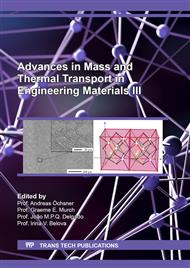p.141
p.152
p.162
p.172
p.195
p.205
p.215
p.231
p.242
Numerical Modeling of Pure and Metal-Foam Loaded PCMs
Abstract:
Despite many desirable properties, most phase change materials (PCMs) undergo timing issues during the phase change process due to a low thermal conductivity, which limits their application in heat storages. Thus, many techniques have been pointed out to overcome these disadvantages and improve heat transfer, such as coupling PCMs with metal inserts, like high porosity open-cell metal foams. Indeed, the presence of a metal foam increases the effective thermal conductivity of the composite medium and speeds up the charging and discharging phases. In the present paper, a numerical model developed in COMSOL ambient has been calibrated by comparison with experimental results on the melting of pure and metal-foam loaded PCMs, placed in a small case and heated from the top by an electric resistance. The numerical model considers the metal foam as a static solid, filled with a phase changing fluid and employs a literature correlation to evaluate the effective thermal conductivity of the composite medium. The performance of two different paraffinic PCMs (RT35 and RT35HC by Rubitherm GmbH, D), loaded either with a copper foam (20 PPI, 95% porosity, by Porometal, China) or with an aluminum one (10 PPI, 96% porosity, by Recemat, NL) has been investigated in terms of speed rate of the phase change front, time required to complete the melting process, temperature distribution and effect of foam porosity. The obtained results clearly evidence the significant heat transfer improvement yielded by metal foams, whose presence increases the effective thermal conductivity of the composite medium (from 0.2 to 7.03 W/mK for copper foam and to 3.52 W/mK for aluminum one), leading to a significant decrease of the charging time and to a lower temperature gradient within the PCM (from about 16 to 3 K).
Info:
Periodical:
Pages:
231-241
Citation:
Online since:
November 2022
Authors:
Keywords:
Price:
Сopyright:
© 2022 Trans Tech Publications Ltd. All Rights Reserved
Share:
Citation:


